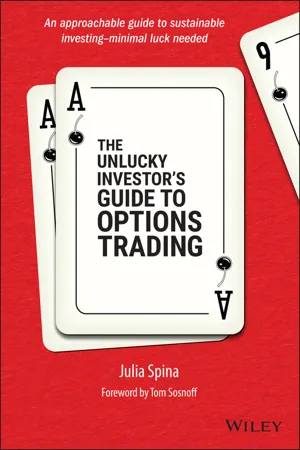
- English
- ePUB (mobile friendly)
- Available on iOS & Android
The Unlucky Investor's Guide to Options Trading
About this book
An approachable guide to sustainable options trading, minimal luck needed.
Traders who are successful long-term do not rely on luck, but rather their ability to adapt, strategize, and utilize available tools and information. Modern markets are becoming increasingly accessible to the average consumer, and the emergence of retail options trading is opening a world of opportunities for the individual investor. Options are highly versatile and complex financial instruments that were exclusive to industry professionals until recently. So where should beginners start? The Unlucky Investor's Guide to Options Trading breaks down the science of options trading to suit interested traders from any background. Using statistics and historical options data, readers will develop an intuitive understanding of the potential risks and rewards of options contracts. From the basics of options trading to strategy construction and portfolio management, The Unlucky Investor's Guide to Options Trading guides readers through the world of options and teaches the crucial risk management techniques for sustainable investing.
Frequently asked questions
- Essential is ideal for learners and professionals who enjoy exploring a wide range of subjects. Access the Essential Library with 800,000+ trusted titles and best-sellers across business, personal growth, and the humanities. Includes unlimited reading time and Standard Read Aloud voice.
- Complete: Perfect for advanced learners and researchers needing full, unrestricted access. Unlock 1.4M+ books across hundreds of subjects, including academic and specialized titles. The Complete Plan also includes advanced features like Premium Read Aloud and Research Assistant.
Please note we cannot support devices running on iOS 13 and Android 7 or earlier. Learn more about using the app.
Information
Chapter 1
Math and Finance Preliminaries
Stocks, Exchange‐Traded Funds, and Options





Table of contents
- Cover
- Table of Contents
- Title Page
- Copyright
- Dedication
- Foreword
- Preface
- Acknowledgments
- About the Authors
- Introduction: Why Trade Options?
- Chapter 1: Math and Finance Preliminaries
- Chapter 2: The Nature of Volatility Trading and Implied Volatility
- Chapter 3: Trading Short Premium
- Chapter 4: Buying Power Reduction
- Chapter 5: Constructing a Trade
- Chapter 6: Managing Trades
- Chapter 7: Basic Portfolio Management
- Chapter 8: Advanced Portfolio Management
- Chapter 9: Binary Events
- Chapter 10: Conclusion and Key Takeaways
- Appendix
- Glossary of Common Tickers, Acronyms, Variables, and Math Equations
- References
- Index
- End User License Agreement